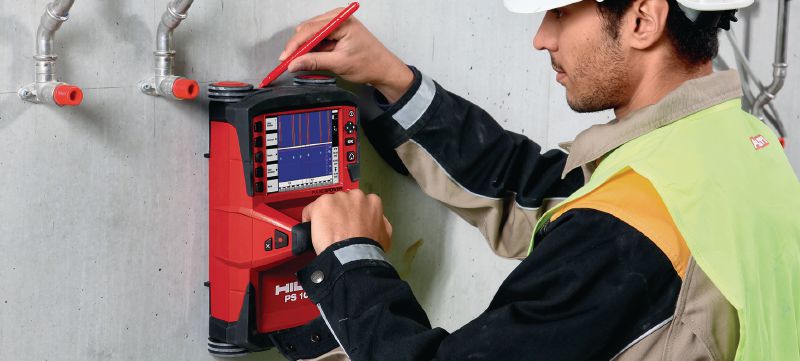Introducing the Power of RainierGPR Concrete Scanning Technology
Introducing the Power of RainierGPR Concrete Scanning Technology
Blog Article
Checking Out the Depths: A Comprehensive Guide to Concrete Scanning and Its Diverse Applications
In the world of construction and infrastructure growth, the thorough process of concrete scanning holds a crucial duty in ensuring the architectural integrity and security of tasks. As technology continues to progress, the applications of concrete scanning have actually increased far beyond simple surface-level analyses.
Significance of Concrete Scanning
Comprehending the value of concrete scanning is crucial in making certain the security and stability of frameworks during building and renovation projects. Concrete scanning uses advanced technologies such as ground-penetrating radar (GPR) and electromagnetic induction to identify embedded items, voids, or other abnormalities within concrete structures.
In addition, concrete scanning plays an essential function in making sure conformity with building ordinance and policies that mandate the protection of existing architectural elements throughout construction tasks. By accurately drawing up the interior make-up of concrete, scanning technologies enable building professionals to make informed decisions that promote the architectural security and resilience of structures and facilities tasks. Essentially, the relevance of concrete scanning hinges on its capability to protect both the architectural integrity and the personnel associated with building endeavors.
Technologies Utilized in Concrete Scanning
Concrete scanning relies upon sophisticated modern technologies such as ground-penetrating radar (GPR) and electro-magnetic induction to properly discover ingrained objects and abnormalities within concrete frameworks. Ground-penetrating radar runs by releasing high-frequency electromagnetic waves into the concrete. When these waves run into different products or spaces within the concrete, they recover to the surface area, permitting the GPR system to create an in-depth subsurface image. This technology is particularly reliable in finding rebar, post-tension wires, channels, and various other things embedded in concrete.
Electro-magnetic induction, on the other hand, functions by creating magnetic fields around a concrete framework with a transmitter coil. When metal things exist within the concrete, they interrupt these electro-magnetic fields, creating eddy currents to move through the metal. By gauging the modifications in the electromagnetic areas with a receiver coil, the system can determine the location of metal things in the concrete.
These cutting-edge modern technologies play a vital function in non-destructive screening, making sure the safety and integrity of concrete structures in various sectors.
Applications in Building And Construction Sector
Within the building and construction industry, concrete scanning innovation locates varied applications that improve task efficiency and safety. One key application is the detection of rebar, post-tension cords, and other embedded objects before drilling or reducing into concrete structures. By precisely mapping out these elements, construction teams can stay clear of costly problems, make certain structural integrity, and prevent prospective security dangers. In addition, concrete scanning is made use of for finding spaces, such as air pockets or areas of wear and tear within concrete, which can endanger the overall stamina of a framework. By identifying these gaps at an early stage, building specialists can take necessary actions to resolve them and keep the longevity of the building. Additionally, concrete scanning plays an you could check here important role in high quality control by verifying the thickness of concrete covers over support, guaranteeing conformity with layout specs and standards. On the whole, the applications of concrete scanning in the building sector contribute dramatically to streamlining task workflows, lowering risks, and supplying top quality outcomes.

Safety And Security Benefits of Concrete Scanning
In the realm of construction safety and security, the application of concrete scanning technology provides a vital benefit in preemptively recognizing possible risks and fortifying structural stability. By using innovative scanning techniques such as ground-penetrating radar (GPR) and electromagnetic induction, building groups can accurately locate rebar, post-tension cords, conduits, and other concealed objects within concrete frameworks. This positive technique significantly minimizes the risk of unexpected strikes throughout exploration, reducing, or coring tasks, consequently stopping costly problems, injuries, and job delays.
In addition, concrete scanning More Bonuses improves worker safety by offering real-time info concerning the structural problem of concrete components. This information enables building specialists to examine the integrity of existing structures, determine degeneration or flaws, and make educated choices regarding repair work and maintenance procedures. By resolving potential safety worries without delay, concrete scanning adds to creating a protected workplace and alleviating the chance of architectural failings or mishaps on construction sites. Eventually, the safety benefits of concrete scanning not just safeguard possessions and lives but additionally support market standards for high quality and dependability.
Future Patterns in Concrete Scanning
Arising innovations in scanning technology are positioned to revolutionize the area of concrete assessment and analysis. One significant fad that is gaining traction is the assimilation of fabricated knowledge (AI) and device understanding formulas into concrete scanning gadgets. By using the power of AI, these systems can examine substantial amounts of data gathered throughout scanning procedures to provide even more detailed and accurate understandings into the condition of concrete structures. This can aid in spotting concealed problems, anticipating potential structural failings, and also recommending maintenance methods.
Another significant fad is the development of even more portable and straightforward scanning gadgets. Miniaturization of scanning equipment enables for much easier access to restricted areas and remote areas, making inspections more comprehensive and reliable. Furthermore, innovations in cordless communication innovations enable real-time information transfer and evaluation, promoting quicker decision-making procedures.
Moreover, there is a growing concentrate on sustainability in concrete scanning technologies - RainierGPR Concrete Scanning. Suppliers are significantly including green products and energy-efficient attributes into their tools to decrease environmental impact. These future trends are readied to boost the performance, accuracy, and sustainability of concrete scanning techniques, shaping the sector's future landscape
Verdict
In final thought, concrete scanning plays a vital role in the building sector official statement by making certain the security and effectiveness of numerous projects. As modern technology advances, the future of concrete scanning holds appealing developments for enhancing construction procedures.

Report this page